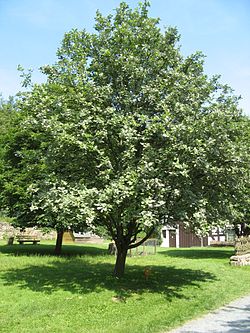| Aria edulis | |
|---|---|
 | |
| Scientific classification | |
| Kingdom: | Plantae |
| Clade: | Tracheophytes |
| Clade: | Angiosperms |
| Clade: | Eudicots |
| Clade: | Rosids |
| Order: | Rosales |
| Family: | Rosaceae |
| Genus: | Aria |
| Species: | A. edulis |
| Binomial name | |
| Aria edulis (Willd.) M.Roem. | |
 | |
| Distribution map | |
| Synonyms | |
List
| |
Aria edulis, the whitebeam or common whitebeam, [2] is a species of deciduous tree in the family Rosaceae .
The tree often forms new shoots around the trunk. Typically compact and domed, the plant has a few upswept branches and the leaves have an almost-white underside. The hermaphrodite cream-white flowers appear in May, are insect pollinated, and go on to produce scarlet berries, which are often eaten by birds. [3]
It is native to most of Europe as well as North Africa (Algeria, Morocco, Tunisia) and temperate Asia (Eastern Turkey, Armenia, Georgia). [4] It generally favours dry limestone and chalk soils.
The cultivars A. edulis 'Lutescens', [5] with very whitish-green early leaves, and A. edulis 'Majestica', [6] with large leaves, have both gained the Royal Horticultural Society's Award of Garden Merit. [7]
The berries are edible when overripe (bletted). [8]
- Tree

